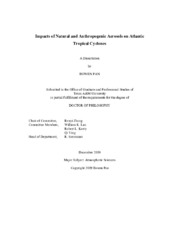| dc.description.abstract | This dissertation investigated the impacts of natural and anthropogenic aerosols on Atlantic tropical cyclones by combining observational analyses and numerical modeling. The objectives of the research were to assess the impacts of anthropogenic aerosols on Hurricane Harvey (2017) and Saharan dust on two hurricanes, Danielle and Earl (2010). Hurricane Harvey made landfall near Rockport, Texas, as a category 4 hurricane on 26 August. Harvey produced heavy rainfall of about 555 mm in the Houston urban area during 25-27 August. Ground- and satellite-based lightning and ground-based radar reflectivity measurements were analyzed, showing unusually intense lightning (over 0.23 million strikes) and radar reflectivity in the Houston region during 26-27 August. The effects of anthropogenic aerosols on precipitation and lightning during Harvey was investigated using a Cloud-Resolving Weather and Research Forecasting (CR-WRF) model.
The ensemble simulations spanned from 25 to 28 August. The simulations show that anthropogenic aerosols increase precipitation and lightning in Houston by a factor of 2-3, unraveling the dominant factor of regulating the energetics and flooding during this extreme weather event. Combined measurements and numerical model simulations were made to show fundamentally altered cloud microphysical and thermodynamic processes of Hurricane Harvey by anthropogenic aerosols. The second part of this dissertation evaluated the impacts of Saharan dust during Hurricanes Danielle and Earl (2010). Hurricanes Danielle and Earl both originated from the West African coast and developed under similar large-scale dynamic conditions and coexisted in the different stages of their life cycles and were subjected to the intrusion of Saharan dust. The CR-WRF was used in conjunction with an aerosol-aware two-moment bulk microphysics scheme, accounting for dust as ice nucleating particles (INPs) and dust radiative forcing. The model simulations reveal that the radiative effect of dust significantly decreases or increases temperature or moisture below 600 mb. The change in the temperature field perturbs the large-scale circulation and alters the tracks of Hurricanes Danielle and Earl. In addition, the dust radiative effect significantly decreases the intensity of Hurricane Earl due to increased vertical wind shear and decreased surface sensible and latent heat fluxes. Dust serving as INPs enhances the formation of ice hydrometeors, but plays an insignificant role in the intensity of both hurricanes. | en |


